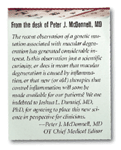Article
New understanding of AMD leads to earlier interventions
The recently reported success with vascular endothelial growth factor (VEGF) inhibitors in patients with age-related macular degeneration (AMD) provides an important new therapeutic modality for wet AMD and an exciting victory for biotechnology. Yet, the best results will eventually come from interventions that target earlier steps in AMD pathogenesis.

Three papers published recently in Science provide new understanding of AMD pathogenesis that should eventually lead to therapy for earlier-stage AMD.

The risk-conferring CFH polymorphisms are common in the general population, but more common in patients with AMD. The most common risk-conferring sequence is present in 29% of controls and about half of AMD patients.5 One particular CFH polymorphism, Y402H, in which the amino acid tyrosine at position 402 is replaced with histidine, was present in 60% of AMD patients, conferring a two- to three-and-a-half-fold risk of advanced AMD. This polymorphism is an attractive candidate for a functional mutation, because it is thought to alter binding between CFH and C-reactive protein, an immune mediator whose levels are increased in AMD.
As an inhibitor of the complement cascade, CFH may help keep harmful inflammation in check in the retina. Inherited CFH polymorphisms might reduce CFH's anti-inflammatory action. A local role for CFH in the retina is plausible, because CFH is made by retinal pigment epithelium (RPE) cells and accumulates in drusen.5
Another link between AMD and CFH comes from the kidney disease membranoproliferative glomerulonephritis (MPGN). Patients with this rare disease often have both retinal drusen and deposits of extracellular material in the kidney. MPGN has been associated with CFH sequence changes.
The hypothesis that inflammation may damage RPE cells and Bruch's membrane and promote neovascularization in AMD is not new, but gains additional support from the genetic CFH evidence. A number of immune mediators, including components of the complement cascade and immunoglobulins, have been found within drusen.5 Further, mice with mutations that inhibit macrophage function develop sub-RPE deposits, neovascularization, and several other features of AMD.6
The stimulus for inflammation in AMD is unclear, but may involve oxidative damage to the retina, leading to the deposition of neo-antigens or self-aggregating molecules in Bruch's membrane. Alternatively, it may involve infectious agents.
While there are no immediate therapeutic or diagnostic implications of the CFH discovery, it is likely that more research will lead to novel therapeutics, such as complement-cascade-inhibiting drugs. Broad-based anti-inflammatory approaches may not be beneficial at all stages of AMD, as evidenced by the implied beneficial function of macrophages in the clearance of subretinal debris in the mouse model.6 Drugs that target specific inflammatory pathways will be needed. Processes that lie further upstream in AMD pathogenesis, such as oxidative stress and infection, are also attractive targets for drugs designed to stop AMD early in its tracks.
Newsletter
Don’t miss out—get Ophthalmology Times updates on the latest clinical advancements and expert interviews, straight to your inbox.





